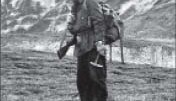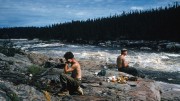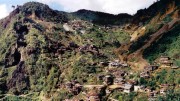Rock is remarkable stuff. It lets you know when it’s not happy, and like the best of us, it gets stressed from time to time. When it gets very wound up, it won’t shut up until something finally happens to calm it down, which is usually not a good thing for we humans. Ask San Francisco.
The rock was yapping away to itself late last year in northwest England, at a fracking site near Blackpool. Cuadrilla, a hydrocarbon explorer, had just restarted operations after being shut down for a while by the regulators because of an increase in seismicity near its drill site. Work was stopped again after the British Geological Survey picked up a swarm of minor earth tremors that were gradually increasing in magnitude. Nothing that you would necessarily notice, but they peaked at 1.1 magnitude in late October, which was felt by some local residents.
The swarm of tremors near Blackpool is remarkable for a supposedly seismically stable area like Great Britain. The island does experience tremors from time to time, some of them quite large, and usually related to Britain’s landmass still wobbling around after the removal of the huge weight of ice that formed during the ice age. But dozens of tremors in one small area are highly unusual, and clearly man-made.
Fracking-related tremors occur because of one of the basics of structural geology that we all learned as young geologists at university: overpressured water or fluid in fractured rock or along fault planes can — when the fluid pressure exceeds the frictional resistance of the fault — act like a lubricant, allowing them to slide and slip, sometimes seismically. All very alarming, I guess, if you live near a fracking site, but also a very predictable outcome from structural geology theory.
I have experienced rock chatter close-up a couple of times. Both times were in the deep-level gold mines in South Africa, when I was an inexperienced geologist in my twenties starting out in the industry. I’m not talking about the big mining-induced shakes we often felt after underground blasting operations. They were impossible to miss, a bit like a truck hitting a house 20 miles from the mine. No, I mean I have been around the low-key evidence of extreme rock stress. These are signs that you don’t necessarily notice until you’re really close to the rock.

The Vaal Reefs mine in South Africa. Photo by Ralph Rushton.
A red flag for miners is euphemistically called “popping.” An overstressed rock face can spontaneously spit out small chunks of rock at high speed, which make a ‘pinging’ noise as they fly off. A bit like the ultra-realistic war movies where you can hear the crack of the bullet passing by a soldier’s head. It happened to me in a vertical shaft we were developing on Vaal Reefs mine, when it had reached a depth of about 900 metres.
I went underground with a colleague from the rock-mechanics engineering department to investigate some stability problems. We arrived at the bottom, just in time to hear regular “ping-ping-ping” sounds, as bits of Ventersdorp lava flew off the wall and did their best to embed themselves in our hard hats. A few days later, there was a much more serious accident at the same spot, when a large part of the sidewall of the shaft spontaneously exploded and killed several people. The cause turned out to be a highly stressed fault plane near the shaft.
The second time I saw signs of impending problems was far spookier, and left a lasting impression. Fortunately, there were no casualties. I was called underground by a mine foreman to visit a working face where his team had been having trouble supporting the roof. The face sloped down to where the pay shoot had been cut off by a fault plane. There were no workers or drillers there so it was completely silent, except for the sound of our voices, as we discussed the issues the foreman had been facing.
The foreman told me quite calmly that the pit props he was installing as support were being squeezed and were taking pressure within a few minutes of installation, the implication being that the roof of the workface was on the move. Never a good sign. And then came the kicker.
“Come with me,” he said. “Let’s go down to the fault at the bottom of the face.”
We crawled on hands and knees, about 50 to 60 metres down the face.
“Listen. You can hear the fault creaking,” he said.
“It’s creaking,” he repeated.
He was right. It was creaking. Clear as a bell, like timbers on a pirate ship in a storm. Seven thousand feet of rock above my head, and there we were, with our hands on a fault plane that was chattering quietly to itself, complaining about the stress it was under. That was beyond a doubt the scariest moment of my career. We left, quicker than we came in, and all work was stopped for 48 hours.
Two days later, a danger crew was dispatched to drill and charge up a single blasting round to move the whole face forward by a metre or so. One. The bonuses reflected the higher-than-average chance the crew faced of being buried under tonnes of jagged rock. They would work one shift to drill and blast a round, then wait another day or two to see if the work induced anything more than rock chatter.
They charged up the face with explosives and it was blown at the usual time, at 1 or 2 a.m. My housemates and I were woken up about the same time by the biggest earth tremor I had ever felt in South Africa, a 5.2 magnitude shake that was detected by the U.S. Geological Survey (USGS) on mainland North America.
The USGS called up the mine rock mechanics department to let them know they had detected it. The ceiling in my bedroom cracked and we rattled merrily for 20 to 25 seconds, a long time for mine-induced bumps. The epicenter was on the fault we had visited two days earlier. The creaking we had heard was a vocal warning from the rocks that change was coming soon.
— Ralph Rushton is a Vancouver-based exploration geologist who once worked in the deep gold mines of the Vaal Reefs region of South Africa.





Be the first to comment on "Odds ‘n’ Sods: Rocks can talk"